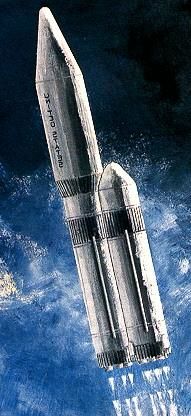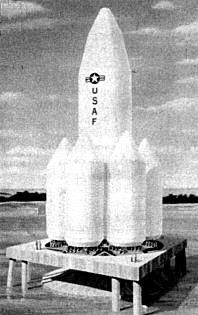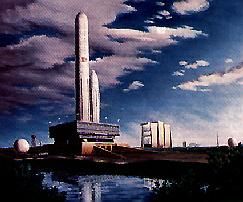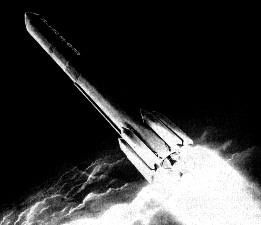
Home - Search - Browse - Alphabetic Index: 0- 1- 2- 3- 4- 5- 6- 7- 8- 9
A- B- C- D- E- F- G- H- I- J- K- L- M- N- O- P- Q- R- S- T- U- V- W- X- Y- Z
ALS
 ALS General Dynamics Credit: Lockheed Martin |
AKA: Advanced Launch System. Status: Cancelled 1988. Thrust: 35,223.87 kN (7,918,641 lbf). Gross mass: 2,340,000 kg (5,150,000 lb). Height: 72.00 m (236.00 ft). Diameter: 8.70 m (28.50 ft).
In the late 1980's the deployment of the ‘Star Wars' ballistic missile defense system was expected to require launch of a small number of heavyweight chemical laser satellites, a moderate number of x-ray laser nuclear-pumped satellites, or a huge number of ‘brilliant pebble' kinetic interceptors. Existing launch vehicles did not have the lifting capacity to support such a program and cost too much per launch.
Seven contractors were awarded five million dollar, one year study contracts in July 1987, with the studies to recommend a family of modular boosters with low earth orbit payloads from 2,400 kg to 90,000 kg. The new launch vehicle was expected to make its first flight in 1998, reach full operational capability of up to 30 flights per year in 2000, and replace all existing expendable launch vehicles by 2005. The studies covered not only the launch vehicle but the ground support equipment as an integrated system.
ALS was expected to exploit the following technologies to cut costs and improve reliability:
- Aluminum-lithium alloys, replacing conventional aluminum, expected to result in 20 percent lower cost and a 10 percent reduction in weight
- Filament-wound composite motor casings, shrouds and interstages to reduce weight.
- Automation to cut the cost of fabrication of composite structures
- Horizontal launch vehicle processing
- New launch complexes and improved checkout procedures
- Engine out capability - clustering of engines such that the loss of one would not prevent the booster from continuing to orbit (this already existed in 1960's in Von Braun's Saturn and Korolev's N1 vehicles).
Proposed were expendable and partially reusable vehicles; fly-back boosters and recoverable propulsion/avionics modules; use of existing engines, solid rockets, or various new liquid engines. Unfortunately there was no single breakthrough new technology identified by the contractors that would result in an order-of-magnitude improvement in launch costs.
By late 1989 the cold war was winding down and ‘Star Wars' was essentially dead. Even if the immense technical problems of developing an operational missile defense could be overcome, it had become possible to reduce or eliminate the ballistic missile threat using treaties rather than technology. Total development cost of ALS was estimated as $15 billion through its first flight in 1998, and the low launch rates expected in the absence of a massive Star Wars deployment could not pay back this investment, even with a substantial reduction in costs per launch. By 1990 the program was reduced to a $150 million per year propulsion development effort. However the technologies identified for use in ALS would be found in 1990's upgrades to the space shuttle, the USAF Evolved Expendable Launch Vehicle program, and numerous commercial booster programs and proposals.
Launch Price $: 141.000 million in 1991 dollars.
Stage Data - ALS
- Stage 0. 2 x ALS. Gross Mass: 780,000 kg (1,710,000 lb). Empty Mass: 60,000 kg (132,000 lb). Thrust (vac): 15,477.159 kN (3,479,404 lbf). Isp: 435 sec. Burn time: 195 sec. Isp(sl): 330 sec. Diameter: 8.70 m (28.50 ft). Span: 8.70 m (28.50 ft). Length: 60.00 m (196.00 ft). Propellants: Lox/LH2. No Engines: 6. Engine: STME. Other designations: Advanced Launch System Core. Status: Study 1988.
- Stage 1. 1 x ALS. Gross Mass: 780,000 kg (1,710,000 lb). Empty Mass: 60,000 kg (132,000 lb). Thrust (vac): 15,477.159 kN (3,479,404 lbf). Isp: 435 sec. Burn time: 195 sec. Isp(sl): 330 sec. Diameter: 8.70 m (28.50 ft). Span: 8.70 m (28.50 ft). Length: 60.00 m (196.00 ft). Propellants: Lox/LH2. No Engines: 6. Engine: STME. Other designations: Advanced Launch System Core. Status: Study 1988.
Family: heavy-lift, orbital launch vehicle. Country: USA. Engines: STME. Stages: ALS stage. Agency: Lockheed, Boeing. Bibliography: 235, 237.
 | ALS Hughes ALS Hughes Aircraft concept. This had an immense number of RL-10 engines firing from identical rocket stages. Also known as 'Jarvis-2' Credit: Hughes |
 | ALS Martin Marrietta ALS Martin Marrietta concept - asymmetric liquid first stage Credit: Lockheed Martin |
 | ALS Martin Marrietta ALS Martin Marrietta concept - liquid core with solid strap-on boosters Credit: Lockheed Martin |
1987 July - . Launch Vehicle: ALS.
- Seven contractors were awarded five million dollar, one year ALS study contracts. - .
Nation: USA.
The studies to recommend a family of modular boosters with low earth orbit payloads from 2,400 kg to 90,000 kg. The new launch vehicle was expected to make its first flight in 1998, reach full operational capability of up to 30 flights per year in 2000, and replace all existing expendable launch vehicles by 2005.
1989 September - . Launch Vehicle: ALS.
- ALS program cutback to a technology development effort. - .
Nation: USA.
Total development cost of ALS was estimated as $15 billion through its first flight in 1998, and in the absence of a massive 'Star Wars' space based defence, the lower launch rates could not pay back this investment. By 1990 the program was reduced to a $150 million per year propulsion development effort.
Back to top of page
Home - Search - Browse - Alphabetic Index: 0- 1- 2- 3- 4- 5- 6- 7- 8- 9
A- B- C- D- E- F- G- H- I- J- K- L- M- N- O- P- Q- R- S- T- U- V- W- X- Y- Z
© 1997-2019 Mark Wade - Contact
© / Conditions for Use